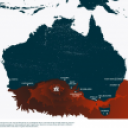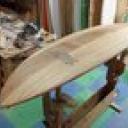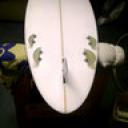Same board, two different constructions


“The Vectornet used on the bottom is an engineering trick to add a bit of spring to the board"
Doesn't really sound like it had more spring and flex...?
"it did feel a tad stiffer flex-wise and didn’t quite knife through the water as well as it’s PU counterpart. It was more prone to skip out when turning hard off the tail, more so than the PU version"


Translation - The Vectornet used on the bottom is a marketing trick and will add a bit of spin to a sales pitch.


I'm thinking of doing the same thing, but with a PU blank and agave.
I've had the blank sitting in my shed for over a year now, just waiting to be shaped into something. At the same time, after discovering the potential for agave to be used as a board-building medium, I've been collecting logs from broad swathe of South Australia, with the intention of building a sustainable board using this most renewable of materials. At this stage, the only thing stopping me is the lack of access to the right tool (an industrial-sized bandsaw that's big enough to enable milling of the agave).
I've been thinking of shaping identical boards out of both materials, so I can then more accurately compare and contrast their characteristics and performance capabilities. The one catch is that my wife would probably have words to say about me building another couple of boards for myself.
On the upside, I'm a relatively creative thinker, so I can probably come up with a story that's reasonably convincing as to why I need another two boards.
On the downside, she has a highly-evolved bullshit meter, so it's unlikely that I'll be able to pull the wool over her eyes.
It all comes down to priorities I guess, and until I find that bandsaw, it's all academic anyway. I know there's a lot of South Australian's out there reading and contributing to Swellnet, so I'll put the call out. Any of you know someone who a) has a big-arsed bandsaw and b) would be willing to let me loose upon it, for the sake of science? I'm based in the Adelaide Hills, but am willing to travel some distance to get this done.


"He found epoxy boards flexed as much as PU boards but they felt stiff cos the bounce back was faster than surfers could discern."
I did notice, when laying on the board and pulling the nose back then letting go abruptly that the "snap-back" felt more dampened on the EPS Directional than it did on the PU. How this translates to flex while surfing, I'm uncertain. Bottom line, it just didn't have that magic zing that the PU version of the board did. Next up is a test between identical Varial Foam blank and a PU blank!
Thanks for posting guys.


I am struggling to inderstand how one paddled better than the other and had more float. Given that they are the exact same dimensions and shape with only a trivial difference in total mass a simple analysis of the physics would suggest they would have the same buoyancy.


There's no need to complicate this ....if the overall weight is the same , they will have the same buoyancy........increasing or reducing the volume will achieve the same weight. The difference will be in the characteristics of the two construction methods, and the materials used..... for quite a few years now , I have questioned the benefits of flex . particularly designed flex in the back half of the board...... I have come to the conclusion that the natural flex that's inherent in all surfboards ,by virtue of their dimensions ,is all the flex you'll ever need.


Not sure what yo're saying there foreday. Buoyancy depends on the density of the material compared to the density of salt water. Changing the volume while keeping the weight the same will therefore change the buoyancy. My point was that if the two boards are the same shape and the same weight they must have the same overall buoyancy.


blindboy wrote:My point was that if the two boards are the same shape and the same weight they must have the same overall buoyancy.
That's absolutely correct blindboy .....but if you switch the core material , for instance , from a polyurethane blank , to 2lb EPS , there will be a substantial difference in either the foam volume or the weight of the glass ..... it generally balance out , because EPS needs heavier glassing than a poly blank..... but , the two boards have an entirely different feel , although they are basically similar in design.


off the rack poly brand boards are totally disposable items.
Any-one who orders customs with half a clue can get a very strong well made pu/pe that is only marginally heavier than a disposable pro board or an eps variant.
Also, these tests without some kind of video footage are so purely subjective as to be useless.


I have had EPS (Tufflite Tufflite 2 and Fibreflex ) boards in the past and enjoyed them - all the pros and cons are well documented above
shaping my own boards the last 5 years Went back to PU and Poly S Glass
had my last PU board glassed in Epoxy standard 4oz glass- It has that lively feel but the familiar performance. A great combo IMO


The results are what id expect but you also have to factor in what the test rider normally rides, people generally like what they are familiar with.
Although that said, if durability wasn't an issue id ride a very light glassed PU/Poly board but they don't last and when you glass them heavier IMO you loose the benefits and feel of a PU/Poly board.
So personally i now limit myself to epoxys boards and buy PU/Poly boards to hang on the wall :D


The fact that a board will flex does not necessarily mean it will return the energy as it regains its original shape. The faster the "snap back" the greater the energy return and if it was too fast for this design with epoxy then it would be worth trying to design a board that would suit that response as it provides potential for greater acceleration. If you think about a bottom turn, the deformation is maintained until the rail is released, the energy returning from the flex should then accelerate the board.


"The faster the "snap back" the greater the energy return and if it was too fast for this design with epoxy then it would be worth trying to design a board that would suit that response as it provides potential for greater acceleration."
I sense that is what Stretch is alluding to in his comments in the interview to which Stu referred.
I could be wrong here, but, isn't the "float and paddle better" difference due to density of the foam core? With the overall weight of each board the same, and the volume of each board the same, the difference is in the density of the foam core used ... EPS being less dense, and thus having more buoyancy?


interesting to see the PU/Polyester board surfed better...with a central stringer.....what was the stringer??
the EPS/epoxy felt stiff...hmm....carbon on the rails actually decreases Torque thru the tail....so feels stiff!
the whole Torque/tortion thru the board seems to have been overlooked ......
So epoxy/PU with a ply stringer.........but probably not as marketable as that black carbon and fancynames??


Wingnut if the volume and weight of the boards is the same their total buoyancy has to be the same. If the mass is distributed differently within them it could potentially cause differences in their performance but I am not sure that this would be a factor here. brutus or someone may have some insight on that but I have to say I suspect the paddling difference was just subjectivity.


Yeah, Blindboy, total weight and volume the same ... density must be the same, principle of physics.
What I'm saying (and as noted, can be completely wrong) is due to the EPS foam core being less dense, and thus lighter in weight, the glassing is heavier to bring total weight of board to be the same. But, due to that lighter core, less dense blank, hence more "air" compared to foam, so more "air" is entrapped into the core of the board (i.e. once the board is glassed), that "air", the "less dense" core, is therefore creating some impact on how the board feels for float and paddling.
Tad academic, but, in the article:
" ... we found their weights to be almost identical - 6 pounds 13 ounces for the PU and 6 pounds 10 ounces for the Superflex ... "
So, the superflex, was slighter lighter overall, and hence "less dense" overall, thus would have a slight more buoyancy. anyway.


brutus wrote:interesting to see the PU/Polyester board surfed better...with a central stringer.....what was the stringer??
the EPS/epoxy felt stiff...hmm....carbon on the rails actually decreases Torque thru the tail....so feels stiff!
the whole Torque/tortion thru the board seems to have been overlooked ......
So epoxy/PU with a ply stringer.........but probably not as marketable as that black carbon and fancynames??
My limited experience so far is the PU with wood stringer + epoxy is the best of both worlds
Would love to make one with parabolic wood stringers - Anyone know where they can be sources in OZ?


brutus wrote:interesting to see the PU/Polyester board surfed better...with a central stringer.....what was the stringer??
the EPS/epoxy felt stiff...hmm....carbon on the rails actually decreases Torque thru the tail....so feels stiff!
the whole Torque/tortion thru the board seems to have been overlooked ......
So epoxy/PU with a ply stringer.........but probably not as marketable as that black carbon and fancynames??
My limited experience so far is the PU with wood stringer + epoxy is the best of both worlds
Would love to make one with parabolic wood stringers - Anyone know where they can be sources in OZ?


.


udo wrote:Surfers Village have a article on all this -Test Driven...glassing,epoxy ,blanks, volume.
Ah, yeah ... isn't that what started this whole thread?


Duh- me. seniors moment.....probably to busy thinking about the pipe model on Rawson site.


Hahahaa ...
You did notice I quoted your comment for the history records?


wingnut2443 wrote:"The faster the "snap back" the greater the energy return and if it was too fast for this design with epoxy then it would be worth trying to design a board that would suit that response as it provides potential for greater acceleration."
I sense that is what Stretch is alluding to in his comments in the interview to which Stu referred.
I could be wrong here, but, isn't the "float and paddle better" difference due to density of the foam core? With the overall weight of each board the same, and the volume of each board the same, the difference is in the density of the foam core used ... EPS being less dense, and thus having more buoyancy?
No, as Blindboy has explained.


brutus wrote:interesting to see the PU/Polyester board surfed better...with a central stringer.....what was the stringer??
the EPS/epoxy felt stiff...hmm....carbon on the rails actually decreases Torque thru the tail....so feels stiff!
the whole Torque/tortion thru the board seems to have been overlooked ......
So epoxy/PU with a ply stringer.........but probably not as marketable as that black carbon and fancynames??
No one has yet shown that flex occurs in the water in any functional way. It certainly can't work as is usually supposed and demonstrated in a land test.


Roy Stuart wrote:wingnut2443 wrote:"The faster the "snap back" the greater the energy return and if it was too fast for this design with epoxy then it would be worth trying to design a board that would suit that response as it provides potential for greater acceleration."
I sense that is what Stretch is alluding to in his comments in the interview to which Stu referred.
I could be wrong here, but, isn't the "float and paddle better" difference due to density of the foam core? With the overall weight of each board the same, and the volume of each board the same, the difference is in the density of the foam core used ... EPS being less dense, and thus having more buoyancy?
No, as Blindboy has explained.
Did they have the same sanded finish , looking really close ie molecular level surely we are looking at different textures . Hence creating different surface tension ?! In regards to paddleability as opposed to just talking buoyancy !


Skin friction drag at paddling speeds is minimal, most of the drag at that speed is form drag, so no it won't make a significant difference.


Roy did you ever do any work on textured surfaces to reduce drag at wave speed?


hi Roy , just a comment on
"No one has yet shown that flex occurs in the water in any functional way. It certainly can't work as is usually supposed and demonstrated in a land test. "
there have been a couple of examples that were too stiff , Surfteck ....and too floppy/soggy flex....sponge soft bds........so somewhere in between those opposite ends of the spectrum there is a need for some flex and torque.
I was part of the test team that used the Tinkler tails at the end of the 70's and had some amzing results.....not supa scientific but none the less did prove that torque was important. The Tinklers guys ..Bob I think was his name came from NZ.....and had the idea to shape a bd with 50% less tail rocker for speed and when the pressure on the bds was increased in turns...the board would flex and turn.like the original design with 50% more lift....you could actually change the flex thru a set of high tension springs.
what we found was that if you completely stiffened the bd up in the centre...and left the rail springs out the bd would twist ...the problem was that I broke evry bd doing bottom turns....but was able to do quite a lot of bottom turns at Bells .....that I never been able to replicate again.......
So there is something in flex and torque.......but to scientifically measure it......working on that this wek with some composite people here in france..exciting stuff....
just for the record usinf S glass on the bottom of a bd is a waste ...as its main feature is to deal with compression issues not flex!!


Hi Brutus,
A bloke by the name of Benjamin Thompson had a scheme to measure flex with accelerometers, it was pumped up big time as the future on the Swaylocks forum. As I thought, when the resulkts came in the flex turned out to be only a fraction of what is achieved in a land test and was in the opposite direction to that which was expected ( by everyone except me). The thread was immediately taken down. I hear what you are saying but the elephant in the room is that no one looks at the water pressure profile under the hull, which is miimal in the tail so a much flexier section is needed there than people think if the tail is going to flex much... as you did with the Tinklers. Of course fin leverage has an effect too as is well known.


Excessive flex increasing performance is a myth.....more flex sheds more energy.....more tail volume gives more instant acceleration when a rail is buried at speed.


brutus wrote:hi Roy , just a comment on
"No one has yet shown that flex occurs in the water in any functional way. It certainly can't work as is usually supposed and demonstrated in a land test. "there have been a couple of examples that were too stiff , Surfteck ....and too floppy/soggy flex....sponge soft bds........so somewhere in between those opposite ends of the spectrum there is a need for some flex and torque.!
Yeah a guy gave me a surf tek board once when i was boardless and broke just to get by and it was so stiff, it kinda surfed okay and was fast but the huge negative of stiffness was it felt every little bump or bit of chop not good for knees but also like riding a bucking bull, and true with the sponge board thing too they can have to much flex and you loose speed and bog.


Hey so with tail flex, what's the deal with Mitchell Rae and Bushrat boards?


Why don't you try polyester board. It is a cost-effective sound absorbing and decorative material, providing excellent acoustic performance when used as polyester wall and ceiling panels. Polyester fibers, as the raw material for polyester board, have a wide range of end uses in the fields of medical care, food storage and display, clothing and bedding, and insulation. This clearly shows a high degree of cleanliness, safety and consumer satisfaction.


Why don't you try polyester board. It is a cost-effective sound absorbing and decorative material, providing excellent acoustic performance when used as polyester wall and ceiling panels. Polyester fibers, as the raw material for polyester board, have a wide range of end uses in the fields of medical care, food storage and display, clothing and bedding, and insulation. This clearly shows a high degree of cleanliness, safety and consumer satisfaction.


Found on the Surfer's Village website. Far as I can tell it is an independent test conducted by SV, and not by the board label. It's something I've been thinking about for a while:
Surfersvillage Global Surf News, 15 March, 2015 - Having recently found a magic board—i.e., one that works in a majority of conditions and responds to my average surfing abilities—I immediately became depressed. It’s a board that works without having to think about where to put my feet, a board that’s fast, loose and paddles great. However, after you find THE ONE, it’s all downhill. Isn’t it?
Sure, you can surf it and be stoked, but what I’ve found is that with each session a little piece of my magic board is lost. And by that I mean to say: in six months this magic polyurethane board creased in two places, had a fin box busted out, and two inches of the nose broken off. Why? Because I’m having a great, reckless, fast, dangerous time surfing it—the way surfing a magic board should be.
So for this test we decided to replicate the magic board in a different, stronger construction to see how it compared. Full disclosure: This is not a truly scientific study. To do that we’d need a wave pool. Or at least a consistent wave. So we came as close as we could, in a variety of California conditions.
We tried the exact same computer-shaped model in an eps core with directional-glass-over-eps construction. The board, a Superbrand 5’10” Unit, is offered in what they call Superflex. There are a few versions of directional-glass-over-eps construction out there with Futureflex by Haydenshapes being the most popular.
Here is a breakdown of the differences in construction:
The Blanks
Magic Board #1.) Polyurethane: The very same material construction surfboard makers have been using for around 60 years—polyurethane foam with a wood stringer running down the center.
“All of the structural support is in the 0 and 90 degree directions (parallel and perpendicular to the stringer)” says Superbrand's Jason Koons. “The results are somewhat predictable, but with fluctuations in foam density and stringer grain the results for two boards shaped exactly the same can vary to a frustrating degree at the highest level of surfing.”
Board #2.) EPS: Koons claims the stringer-less eps core blanks are super predictable in flex and yield nearly the exact same results every time between two blanks. “Because the core has a consistent density from board to board and the multilayered glassing schedule is multidirectional we get a light predictable controlled product,” he added.
Glassing
1.) Polyurethane: The magic PU board is glassed with one layer of fiberglass S-cloth on the bottom and two layers on the top and set with polyester resin.
2.) Superflex: Glassed with a layer of glass that has additional strands following the nose-to-tail direction called Warp glass. Think of it as going with the grain in wood instead of against it. Then they add Vectornet (the net-looking stuff on the bottom) which adds strength and controls flex further.
“The Vectornet used on the bottom is an engineering trick to add a bit of spring to the board,” says Koons. “The material used to make the Vectornet has very little structural value. The Vectornet frays a bit during application so to keep it looking clean we spray the rails of the blank black,” he adds.
The deck then gets glassed with regular glass and Warp glass.
What We Discovered:
The directional-glass-over-eps construction is much more durable. We dropped it on the sidewalk, paddled over a rock in the lineup and pulled into some thumping closeouts. The board received not a scratch.
Setting the two boards side-by-side then weighing them on a digital scale, we found their weights to be almost identical - 6 pounds 13 ounces for the PU and 6 pounds 10 ounces for the Superflex.
How did it surf?
I really liked the Superflex board. It surfed lively and well. Conversely, it did feel a tad stiffer flex-wise and didn’t quite knife through the water as well as it’s PU counterpart. It was more prone to skip out when turning hard off the tail, more so than the PU version (we tested both boards with the exact same Futures JC1 Blackstix fins).
For fifty percent of the sessions on the Superflex board it went fine. The other sessions it didn’t have that magic ‘zing’ —especially in bumpy surf.
Of the two constructions, the Superflex paddled better and felt as though it had more float than the PU board (remember, exact same dimensions) which helped during sessions in more gutless surf.
We liked the PU board better for performance, liveliness and responsiveness. Though, had I jumped on the Superflex construction first, I might be totally satisfied with that construction, after all we are comparing it to a ‘magic board’. One thing's for certain, I did not like how fragile the PU construction feels compared to the Superflex.
For this reviewer’s performance needs, the Superflex board is a good board; the PU counterpart is a great board.
Durability:
Superflex wins
Float:
Superflex wins
Performance:
Polyurethane wins
Familiarity:
Polyurethane wins
Flex:
Polyurethane wins